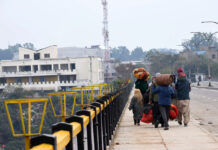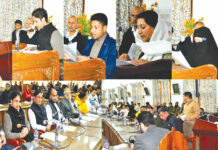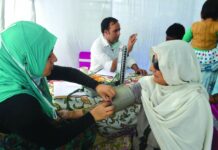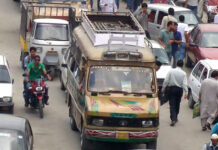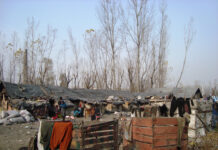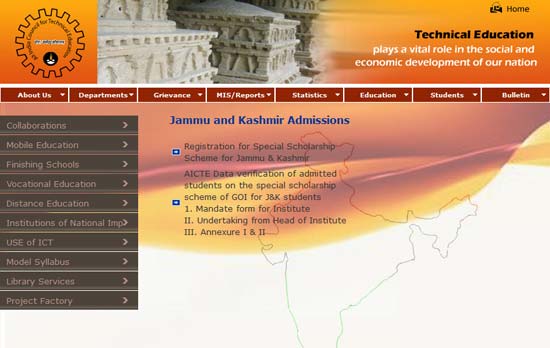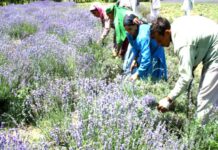The minuscule Sikh community in Kashmir heaved a sigh of relief after the departure of US President Barack Obama from New Delhi. Two incidents during Obama’s three day stay in India recreated the fear psychosis among the community members haunted by the massacre of its 35 members at Chittisinghpora village in March 2000, on the eve of then US president Bill Clinton’s India visit.
“Yes, we are relieved. We are safe in Kashmir under the patronage of the majority community, which has never failed us,” said Chairman of all-party Sikh Coordination Committee Jagmohan Singh Raina. “Of course, we were frightened. We are afraid of the conspiracies hatched by Indian and Pakistani agencies. They can play any bad game to spoil the composite culture of Kashmir Valley for their petty interests.”
Before Obama’s visit, the security grid in Kashmir was tightened to ensure safety of the minority Sikh and Pandit communities. Not only the separatists and Sikh bodies expressed apprehensions that “unidentified people” may repeat Chittisinghpora-like incidents; the union home secretary also shared the apprehension. He said that militants may try to seek attention by repeating Chittisighpora and eventually pass the blame on to the Army.
Three days before Omaba’s arrival, Chief Minister Omar Abdullah convened a special meeting of the Unified Command to review security. The security forces were instructed to ensure safety of the minority communities.
 However, two incidents in north and south of the Valley created a scare among the communities. “In a matter of three hours,” says Raina, “Army personnel knocked at the doors of Sikh houses at Upalna Baramulla and Hutmurrah Anantnag asking the residents to come out”. The panicked residents came out in large numbers and chased away the army personnel. “The motives of the army are still not known,” he said.
However, two incidents in north and south of the Valley created a scare among the communities. “In a matter of three hours,” says Raina, “Army personnel knocked at the doors of Sikh houses at Upalna Baramulla and Hutmurrah Anantnag asking the residents to come out”. The panicked residents came out in large numbers and chased away the army personnel. “The motives of the army are still not known,” he said.
The residents of Hutmurrah village said that gunmen in uniform disembarked from a Sumo late on Nov 5, evening and asked the male members of the Sikh community to come out of their houses. The already alarmed community refused to open the doors and began shouting slogans. Then, hundreds of men, women and children left their homes with swords and kripans (daggers) and chased away the gunmen at the village near Anantnag-Pahalgam road.
They seized the vehicle and overpowered the local driver who later told the police that he was hired by 3 Rashtriya Rifles troops. Soon after the incident, police rushed to the spot. Deputy Inspector General of Police (south Kashmir range) Shafqat Watali confirmed the gunmen belonged to 3 RR and had “apparently gone to the village in good faith”.
The Chief Minister ordered an inquiry into the incident, which prompted the police to file a First Information Report against the Rashtriya Rifles unit. Before the Hutmurrah incident, residents in Uplana village of Baramulla faced similar situation when they spotted army men “roaming in suspicious manner” in the village. Locals say that army men were not used to frequenting the village. SSP Baramulla Mansoor Untoo said that the army men were looking for a mechanic and eventually knocked at a door.
“They did not know the context that the knocking can create panic,” he said. Thanks to prompt communication system, the Sikh residents across the length and breadth of the Valley were alerted, said Harpal Singh, a contractual teacher in south Kashmir. “I could not sleep for the entire night, nor did anyone in my family,” he said.
Raina told Kashmir Life that the Sikh leaders filed separate written complaints with Chief Minister Omar Abdullah and Union Home Minister P Chidambaram. “We got a quick response from the CM but the response from the Home Minister is still awaited,” he said. He said that the police have not lodged an FIR in Upalna incident.
The Sikh organisations in Kashmir described the two incidents as “unfortunate” and reiterated their demand for impartial probe of the Chittisinghpora massacre. In Hutmurrah, which falls closer to Chittisighpora, many families have relatives in the ill-fated village. They staged a protest demonstration seeking probe into the three incidents.
In March 2000, gunmen in army fatigues swooped on Chittisighpora village and massacred 35 members of the community after bringing them out from their houses on gunpoint. They were lined along walls of two gurdwaras and shot dead in cold blood.
While the government blamed separatist militants of Hizbul Mujahideen and Lashkar-e-Toiba for the carnage, the separatists say that it was the handiwork of the Indian security forces. Interestingly, the government has not agreed to hold an impartial probe into the incident.
Police and Rashtriya Rifles killed five people in an “encounter” at Pathribal claiming that they were foreign mercenaries responsible for the carnage. However, the five turned out to be turned local civilians who had been picked up from their residences and killed in a “staged” encounter.
Their bodies were charred beyond recognition and were identified by DNA tests. The exposure of the fake encounter added to the mystery of the Chattisighpora massacre.


